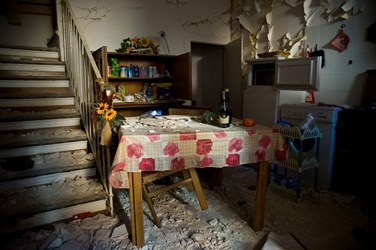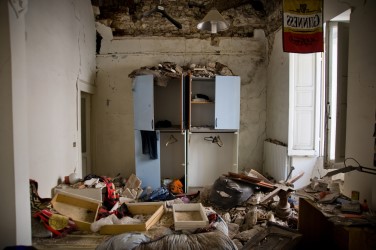13 March 2017
Predicting earthquakes
From Japan to United States, the state of the art in earthquake and tsunami warning systems
From Japan to United States, the state of the art in earthquake and tsunami warning systems
The citizens of Japan live with the knowledge that the next ‘Big One’ is on its way. According to the scientific community, it will probably be even more devastating than the earthquake that struck the country in 2011. For this reason scientists in Japan and the United States are trying to develop earthquake and tsunami warning systems. The governor of California has already announced a project that could be active in 2018, while others are attempting to utilize smartphones as sensors.

For Greg Beroza, professor of geophysics at Stanford University, the idea came about while shopping in an electronics store, holding up his smartphone to use Shazam to find out the name of a song playing in the background. I thought “Cool! I want to do the same thing for earthquakes.” So 2015 saw the birth of FAST - Fingerprint And Similarity Thresholding – a system that uses an algorithm to recognise and classify earthquakes. The concept is the same as that of Shazam: in just a few fractions of a second the system is able to isolate a section of sound waves, in this case from an earthquake, and compare it with all of the other sections on the database, including those from many years ago. Earthquakes occurring on the same fault line, in fact, share similar sound waves so with FAST it is then possible to map the earthquakes and understand which areas are most at risk and what intensity of tremor can be expected.
It may be too soon, however, to answer the age-old question of whether earthquakes can be predicted. In the 1900s numerous projects were developed and found to be unsuccessful. Nowadays, thanks also to the Internet of Things (IOT), many scholars believe that what was once considered impossible may become reality. But is this just the latest chimera?
Japan and the United States face each other across the Pacific Ocean in the area of the globe most at risk from seismic activity: the Ring of Fire, as it is also known, is the location of 90% of the planet’s earthquakes.
The quake on 11 March 2011 in Sendai and Tōhoku (8.9 on the Richter scale), which also caused a tsunami, was the most devastating ever recorded in Japan and is still considered the country’s worst catastrophe since the Second World War, even worse than the 1995 earthquake in Kobe, due to the damage caused to the nuclear power plant in Fukushina Dai-chi. The Tsunami reached the Japanese coast less than one hour after the first tremors and 10-metre high waves flooded an area of 561 km2. In just nine and a half hours it crossed the Pacific and arrived on the West Coast of the USA where it caused limited damage, while 22 hours after the initial earthquake the tsunami had propagated throughout the Pacific Ocean. The Organization for Economic Co-operation and Development (OECD) estimates that the damage caused equalled around 2% of Japan’s GDP, some consider the actual figure to be much higher.
The problem is that the next earthquake will be worse. Japan has been expecting the next ‘Big One’ since at least 2013, when the Japanese Prime Minister Shinzo Abe stated what might have been better left unsaid - that the next earthquake will occur within the next 30 years with a magnitude of 8.0 or 9.0, hitting the Nankai Trough, an area that has been blighted by earthquakes with a tragic regularity over the centuries. The Japanese premier went on to urge the population to be “calm and appropriately afraid”.
The details are important: according to the government the big one is 50% likely to occur in the next 20 years, 70% likely within the next 30 and 90% likely within the next half century. The damage? This has been estimated at 323 thousand deaths, of which 230 thousand will be caused by the impact of the tsunami, 82 thousand by the collapse of buildings and 10 thousand by fires. The damage, however, could be incalculable if we consider that the region affected represents one of the country’s main industrial centres. In that area is located Fanuc, the leading company in the production of robots but also a Toyota factory that produces 1.6 million cars per year and a large number of Japanese parts suppliers to Boeing.

The big one that struck Japan in 2011, however, taught some valuable lessons. On that occasion, also thanks to studies by the Earthquake Research Institute of the University of Tokyo, experiments began on a system involving thousands of electronic sensors located all across the country that can send warnings in just a few seconds. The system, which is known as EEW, or Earthquake Early Warning, is a project of the Japanese Meteorological Agency (JMA) and alerts both the National Hydrogeological Service and the general public.
The system has generated curiosity also in the US. Particularly sensitive to the problem is California, famous for the devastating earthquakes along the San Andreas Fault: it is estimated that in the coming 30 years the San Francisco Bay area and Southern California have a 72% probability of being hit by an earthquake of at least 6-7 degrees in magnitude. In September the California governor, Jerry Brown, announced that by the end of 2018 Californians would be able to receive a warning system direct on their phones called ShakeAlert. How does it work? ShakeAlert is able to identify and classify an earthquake just a few seconds after it begins through the energy emitted in the so-called P waves, also called longitudinal waves, which originate at the epicentre and spread through rock in successive compressions and dilations, provoking variations in the rock’s volume. Through this information the system can predict and warn the population with some tens of seconds’ notice (a figure that varies according to the distance from the epicentre) and potentially alert vulnerable infrastructure.
Thanks to systems such as ShakeAlert it is possible to slow down trains or prevent planes from taking off or landing, stop traffic from entering tunnels or crossing bridges, warn people to move away from dangerous chemical machines or shut down or isolate particular industrial plants. The smart cities of the future will probably include earthquake and tsunami warning systems.
The Generali Group has been supporting a three year study into the analysis and mitigation of effects of seismic risks, in collaboration with the Abdus Salam International Centre for Theoretical Physics (ICTP), the world’s leading scientific institution in the field of research and the transfer of knowledge to developing countries, in Trieste that operates under a tripartite agreement between the Italian government, the International Atomic Energy Agency (IAEA), and the United Nations Educational, Scientific and Cultural Organization (UNESCO). The research, which will be completed in 2018 is focussed on the development of a model and will examine a combination of seismic faults in the area between Friuli Venezia Giulia and Istria in the northern part of the Mediterranean. The model will facilitate the analysis of the behaviour of the faults through data and simulations of a geological and seismological nature in addition to satellite information and will be applicable in other areas of the world exposed to seismic risk, while also encouraging the development a scientific culture of prevention and mitigating the consequences of earthquakes.
Not all natural disasters are the same, however. The reaction time necessary to avoid damage in the case of earthquakes is just a matter of seconds, minutes for tornadoes, hours in the case of floods and even days when it comes to fires and hurricanes. Yet still earthquakes, in contrast to hurricanes, fires and tornadoes, do not show any visible signs that warn of their arrival. One of the main drawbacks of warning systems, however, is the false alarm. Try to imagine the consequences of a false alarm in a school, a rock concert or a shopping centre? In some cases the consequences of causing panic could be even worse than those of an actual earthquake. For this reason the research is of great importance but the costs are very high and the time needed to be able to “predict” earthquakes is substantial. Furthermore, many countries at risk from seismic activity (Peru, Iran, Nepal) cannot afford the investment in technology that Japan and the US are making.
In order to overcome this problem a group of scientists led by a geologist from then Menlo Park Science Center in California, Sarah E. Minson, have written an article in Science about an experiment taking place that has caused a stir in seismology circles. The model involves the use of smartphones and an EEW using crowdsourcing, the automatic collection and exchange of information, with software and hardware interventions for mobile devices to adapt them into sensors. The Big One app looks set to become a must.
